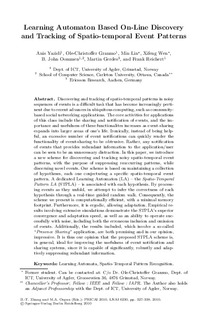| dc.identifier.citation | Yazidi, A., (2010). Learning Automaton Based On-Line Discovery and Tracking of Spatio-temporal Event Patterns. In B. T. Zhang, & M. A. Orgun (Eds.), PRICAI 2010 : Trends in Artificial Intelligence. Lecture Notes in Computer Science, 6230, 327-338. Springer. | en_US |
| dc.description.abstract | Discovering and tracking of spatio-temporal patterns in noisy sequences of events is a difficult task that has become increasingly pertinent due to recent advances in ubiquitous computing, such as community-based social networking applications. The core activities for applications of this class include the sharing and notification of events, and the importance and usefulness of these functionalites increases as event-sharing expands into larger areas of one’s life. Ironically, instead of being helpful, an excessive number of event notifications can quickly render the functionality of event-sharing to be obtrusive. Rather, any notification of events that provides redundant information to the application/user can be seen to be an unnecessary distraction. In this paper, we introduce a new scheme for discovering and tracking noisy spatio-temporal event patterns, with the purpose of suppressing reoccurring patterns, while discerning novel events. Our scheme is based on maintaining a collection of hypotheses, each one conjecturing a specific spatio-temporal event pattern. A dedicated Learning Automaton (LA) – the Spatio-Temporal Pattern LA (STPLA) – is associated with each hypothesis. By processing events as they unfold, we attempt to infer the correctness of each hypothesis through a real-time guided random walk. Consequently, the scheme we present is computationally efficient, with a minimal memory footprint. Furthermore, it is ergodic, allowing adaptation. Empirical results involving extensive simulations demonstrate the STPLA’s superior convergence and adaptation speed, as well as an ability to operate successfully with noise, including both the erroneous inclusion and omission of events. Additionally, the results included, which involve a so-called “Presence Sharing” application, are both promising and in our opinion, impressive. It is thus our opinion that the proposed STPLA scheme is, in general, ideal for improving the usefulness of event notification and sharing systems, since it is capable of significantly, robustly and adaptively suppressing redundant information. | en_US |
